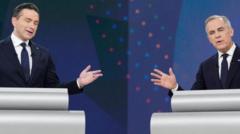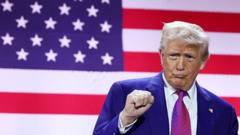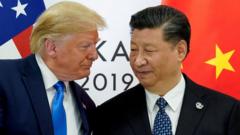The final debate among Canada's major party leaders reflected pressing national concerns while showcasing their campaign strategies against a backdrop of competition and civility.
Canada's Election Debate: Key Insights and Leaders' Performances

Canada's Election Debate: Key Insights and Leaders' Performances
In the lead-up to the Canadian general election, leaders debated crucial issues impacting the nation.
In a closely-watched debate ahead of this month's national election, leaders of Canada's four principal political parties tackled a range of significant issues. While trade relations with the US - especially under President Trump - loomed large, the discussion spanned topics including affordability, crime, and environmental concerns. Here are five notable takeaways from the event:
1. Carney vs. Trudeau's Legacy
Liberal leader Mark Carney found himself defending against critiques referencing former Prime Minister Justin Trudeau’s administration. Conservative leader Pierre Poilievre was particularly aggressive, resurrecting phrases like the "lost Liberal decade," questioning Carney's ability to diverge from his predecessor's policies. "You need to prove you are better," challenged Bloc Québécois leader Yves-Francois Blanchet, intensifying the scrutiny on Carney to distance himself from Trudeau’s unfavorable legacy.
2. Addressing Trump’s Tariffs
The candidates were extensively questioned on their strategies for handling US tariffs imposed by Trump. Although historically, Canada has favored a retaliatory approach, Carney suggested a shift toward more targeted tariffs to minimize the impact on Canadians. This reflects a recognition of the imbalance between the economies of the two nations, marking a departure from the more aggressive "dollar-for-dollar" stance of prior discussions.
3. Policy Details Matter
Beyond the prominent theme of US relations, the debate revealed the candidates' divergent policy visions. Poilievre touted a small-government philosophy aimed at stimulating economic growth, while New Democratic Party leader Jagmeet Singh promoted the expansion of national health programs. Carney navigated a centrist perspective, emphasizing a catalytic role for government intervention, while Blanchet focused on Quebec's unique identity and interests, revealing the varied electorate choices.
4. Smaller Parties Struggling for Visibility
The dynamics of Canada's multi-party system came into sharp focus as smaller parties like Singh's New Democrats sought to maintain relevance. Singh's interruptions aimed to elevate his party's platform amidst projections of significant losses in the upcoming election. Blanchet strategically inserted Quebec-centric issues to secure regional support, illustrating the challenges faced by smaller factions in gaining voter traction.
5. An Unexpected Civil Discourse
Despite the competitiveness of the debate, the atmosphere remained largely civil compared to similar political confrontations elsewhere. Leaders expressed a mutual respect, particularly noticeable in their post-debate interactions where even moments of tension appeared to dissolve into shared laughter. This civility contrasts sharply with trends observed in other western political landscapes, depicting a unique characteristic of Canadian politics.
These insights from the debate offer a glimpse into the competing narratives and strategies as Canada heads toward its election, underscoring the importance of both domestic and international issues in shaping the electorate's decisions.
1. Carney vs. Trudeau's Legacy
Liberal leader Mark Carney found himself defending against critiques referencing former Prime Minister Justin Trudeau’s administration. Conservative leader Pierre Poilievre was particularly aggressive, resurrecting phrases like the "lost Liberal decade," questioning Carney's ability to diverge from his predecessor's policies. "You need to prove you are better," challenged Bloc Québécois leader Yves-Francois Blanchet, intensifying the scrutiny on Carney to distance himself from Trudeau’s unfavorable legacy.
2. Addressing Trump’s Tariffs
The candidates were extensively questioned on their strategies for handling US tariffs imposed by Trump. Although historically, Canada has favored a retaliatory approach, Carney suggested a shift toward more targeted tariffs to minimize the impact on Canadians. This reflects a recognition of the imbalance between the economies of the two nations, marking a departure from the more aggressive "dollar-for-dollar" stance of prior discussions.
3. Policy Details Matter
Beyond the prominent theme of US relations, the debate revealed the candidates' divergent policy visions. Poilievre touted a small-government philosophy aimed at stimulating economic growth, while New Democratic Party leader Jagmeet Singh promoted the expansion of national health programs. Carney navigated a centrist perspective, emphasizing a catalytic role for government intervention, while Blanchet focused on Quebec's unique identity and interests, revealing the varied electorate choices.
4. Smaller Parties Struggling for Visibility
The dynamics of Canada's multi-party system came into sharp focus as smaller parties like Singh's New Democrats sought to maintain relevance. Singh's interruptions aimed to elevate his party's platform amidst projections of significant losses in the upcoming election. Blanchet strategically inserted Quebec-centric issues to secure regional support, illustrating the challenges faced by smaller factions in gaining voter traction.
5. An Unexpected Civil Discourse
Despite the competitiveness of the debate, the atmosphere remained largely civil compared to similar political confrontations elsewhere. Leaders expressed a mutual respect, particularly noticeable in their post-debate interactions where even moments of tension appeared to dissolve into shared laughter. This civility contrasts sharply with trends observed in other western political landscapes, depicting a unique characteristic of Canadian politics.
These insights from the debate offer a glimpse into the competing narratives and strategies as Canada heads toward its election, underscoring the importance of both domestic and international issues in shaping the electorate's decisions.






















